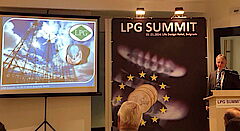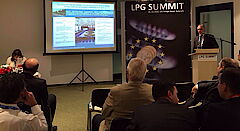TRACECA Corridor as one of Mutually Beneficial Options for LPG Delivery to the Countries of Western and Eastern Europe
During 10 years the traditional annual LPG Summit (liquefied petroleum gas) has been gathering the multitude of important entrepreneurs of business structures from the EU, South-Eastern Europe, Russia and other countries and regions with the view of establishing business contacts and discussing business proposals both in the region and beyond it.
LPG Summit was attended by traders, services providers, representatives of petroleum refineries, customers, logistic providers, local authorities, representatives of main LPG associations, partners with potential capacities.
During the recent LPG Summit held on 19-20 November 2014, in Belgrade, Serbia, the active discussions were held on the issue of the increase of demand for liquefied petroleum gas and its consumption amounts as well as sharing experience and knowledge regarding the choice of optimal routes of its transportation to world markets.
The participants in the meeting noted that for several decades the use of petroleum gas had increased up to more than 200 million tons. On the world market the demand for liquefied petroleum gas increases quicker than for crude oil and tends to permanent growth both due to toughening of ecological requirements and by reasons of relatively high prices for light oil. By 2020 its consumption will be priced at 300 million tons a year.
The dynamics of trade development of the countries and whole regions, particularly between the regions of Europe and Asia will bring about the increased demand for freight traffic. At that the role of transport communications ensuring international foreign operations is very important.
Mr. E. Biriucov, Secretary General of TRACECA in his speech noted that in the technical aspect the TRACECA corridor represents a multi-modal complex of land and sea routes connecting Central Asia with Europe both through South Caucasus and through Iran and Turkey. It contributes to the improvement of trade relationship between regions, favours closer relations among the interested business circles, mending of mutually beneficial cooperation between the energy supplying countries and consumers. All in all more than 70 million tons of various goods are transported annually along the corridor routes, the share of energy making about 75%.
Particularly energy resources of Central Asian and Caucasian countries are mainly concentrated in four countries: Azerbaijan, Kazakhstan, Turkmenistan and Uzbekistan. The estimates of the proved resources vary, but in the aggregate these reserves surpass those of the North Sea.
Speaking of the liquefied petroleum gas Mr. Biriucov informed that presently the total production volume of this type of fuel makes in these 4 countries around 3.7 million tons, 2 million of which may be sent for export. Taking into consideration the actual situation on the market of LPG sales in the region, around 200 thousand tons of this produce may be transported subject to technical parameters of infrastructure and vehicles. But this figure may increase provided there are assigned additional investments.
At present such traffic is performed by road and railway-ferry transport, with all necessary infrastructure and relevant conditions available.
Country:
Mode:
Published:
Permanent Secretaritat of the IGC TRACECA







